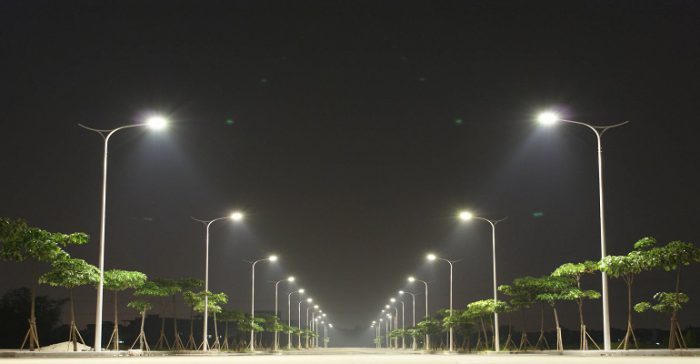Chicago dials down LED street lamp intensity — and controversy
Written by Kevin Stark, energynews.us, March 7, 2018
As the city of Chicago begins converting more than a quarter-million street lamps to high-efficiency LEDs, the light — and public reaction — hasn’t been as harsh as what was seen in cities that were earlier adopters.
“It’s definitely a cleaner light, and it feels safer in general,” said Andrew Shedden, 36, as he walked his dog Odie along Touhy Avenue on a recent afternoon under a bank of newly installed LED street lights.
The Chicago Department of Transportation has already upgraded 18,000 lamps, and by 2021 it plans to install 270,000 of the energy-saving lights, which up to three-quarters less electricity than high-pressure sodium lamps.
“The Chicago Smart Lighting Program is off to a great start, delivering modern, reliable, energy-efficient lighting that is already improving quality of life in Chicago neighborhoods,” Chicago Mayor Rahm Emanuel said.
The city piloted the LED lights in a handful of neighborhoods beginning in December of 2016 and left public comment open for more than a year. Chicago Department of Transportation Commissioner Rebekah Scheinfeld said it was important to conduct field tests “so that both residents and our lighting experts can see how these lighting levels perform.”
The conversion to LED street lamps prompted public backlash in cities like Seattle and New York, where residents complained that the first-generation of lights were too bright and bothersome. One critic in New York called them “ghoulish” and “invasive.” Some complaints were bolstered by an American Medical Association paper that warned of glare and sleep problems.
Chicago hasn’t been immune to such criticism — on a neighborhood forum, residents complained of “painful and piercing intensity light” — but it’s been relatively muted compared to the controversy in other cities.
In part, at least, that’s because Chicago’s LED lamps are not as intense as those installed in other cities.
Street lights are measured in kelvin, which designates the color temperature. The earlier generations of LED street lamps had temperatures as high as 4,000K or 5,000K. Chicago’s will be 3,000K and able to be dimmed remotely during off-peak times, meeting two of the three AMA guidelines.
AMA also recommends that LED have proper lighting shields. Chicago’s won’t, but city officials say on they are willing a case-by-case basis to further dim or shield problematic lamps, for example if light bleeds into resident’s windows.
Those type of considerations are important, according to the AMA guidance, for a couple of reasons. High-intensity street lamps can create worse nighttime glare than conventional lighting, its paper said, and their blue-rich tone can disrupt sleep patterns.
“Recent large surveys found that brighter residential nighttime lighting is associated with reduced sleep times, dissatisfaction with sleep quality, excessive sleepiness, impaired daytime functioning and obesity,” according to the paper.
Improved public safety, after energy savings, was a main selling point of the city’s LEDs. City officials have said the lights will help police and firefighters by emitting a clear light that will make it easier for them to see.
“Through modernizing our infrastructure, the city will save money over the long term by lowering energy costs, vastly improving the lighting on our streets and alleys, and making our neighborhoods safer,” Chicago Treasurer Kurt Summers said.
[mks_button size=”small” title=”This article was written by Kevin Stark and was originally posted on energynews.us ” style=”squared” url=”https://energynews.us/midwest/chicago-dials-down-led-street-lamp-intensity-and-controversy/” target=”_blank” bg_color=”#dd9933″ txt_color=”#FFFFFF” icon=”” icon_type=”” nofollow=”0″]
